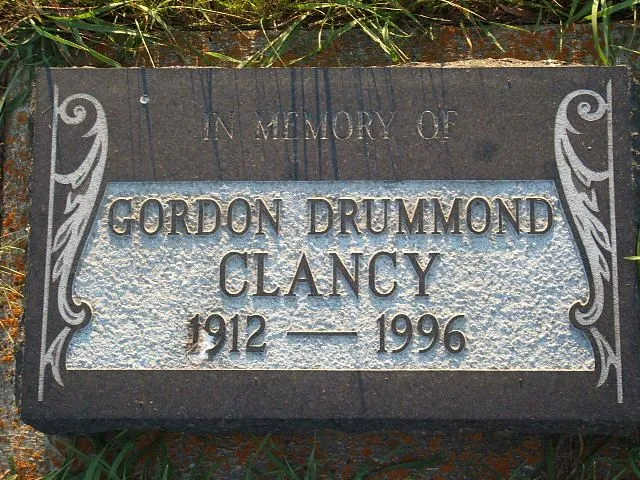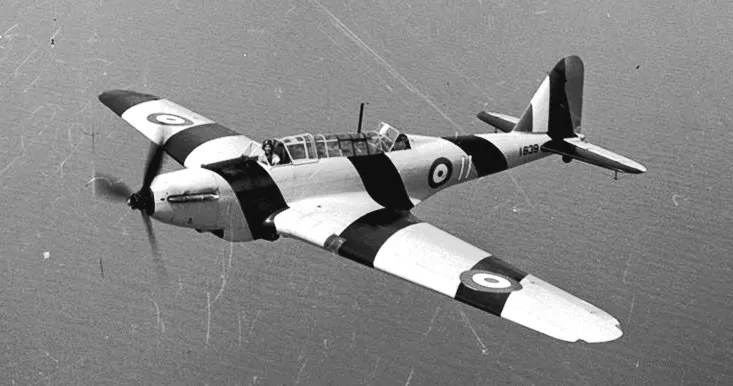(Library and Archives Canada Photo, MIKAN No. 3199067)
Fairey Battle, RCAF (Serial No. 1639), wearing target towing stripes, used in bombing and gunnery training, July 1941.
The Fairey Battle is a British designed single engine light bomber, used as a trainer in the RCAF. The Battle was powered by the same high-performance Rolls-Royce Merlin piston engine that powered various contemporary British fighters including the Spitfire. It was, however significantly heavier, with its three-man crew and bomb load. Although it was a great improvement over the aircraft that preceded it, the Battle was relatively slow and limited in range. It was only armed with two .303 in machine guns facing the rear, and was found to be highly vulnerable to enemy fighters and anti-aircraft fire.
The Fairey Battle participated in direct combat missions during early stages of the Second World War and earned the distinction of attaining the first aerial victory of an RAF aircraft in the war. In May 1940 the Battle suffered heavy losses, frequently in excess of 50 percent of aircraft sortied per mission. By the end of 1940 the type had been entirely withdrawn from active combat service, and was relegated to training units overseas, with many serving in Canada.
The RCAF received its first batch of eight Battles in August 1939, at RCAF Station Borden, Ontario. A total of 802 Battles were eventually delivered from England, serving in various roles and configurations, including dual-control trainers, target-tugs, and gunnery trainers for the Bombing and Gunnery schools of the Commonwealth Air Training Plan. Canadian use of the Battle declined as more advanced aircraft, such as the Bristol Bolingbroke and the North American Harvard were introduced. Battles remained in RCAF service until shortly after the end of the war hostilities in 1945. No. 111, 115 and No. 122 Squadrons of the RCAF flew Battles.
Fairey Battles were not manufactured in Canada, but they were assembled, serviced and modified here, including the installation of turrets at the Canadian Car and Foundry plant in Montreal.
Harold Skaarup web page with revisions
 Wikipedia Fairey Battle Bomber
Wikipedia Fairey Battle Bomber
 Harold A Skaarup Web Page
Harold A Skaarup Web Page
 Fairey Battle - Kestrel Publications
Fairey Battle - Kestrel Publications
12 (B) Sqn Leads the Field ()
No 12 Squadron RFC was formed at Netheravon on 4th February 1915. From 1916 to 1918 it was employed in a ground support role. It was part of the Army of Occupation at the end of WWI and was then disbanded at Bickendorf, Germany in July 1922. It was re-formed at Northolt, Middlesex in April 1923 as a bomber squadron flying DH 9A's. In 1924 it received Fairey Fawn aircraft, and later these were replaced with Fairey Foxes. From October 1935 until August 1936 it was based at Aden to reinforce RAF Middle East Command. On returning to England it re-equipped with Hawker Hinds and was based at Andover, Hampshire, until May 1939, by which time it was equipped with Fairey Battles.
From May 1939 until the outbreak of WWII the squadron was based at Bicester, Oxfordshire, the moved to France in September of 1939. It was based at a number of airfields in France, successively Berry-au-Bac, Amifontaine, Echemines and Souge. It returned to England in July 1940. During its stay in France, the squadron formed part of the Advanced Air Striking Force. During the German invasion of Belgium and France in May 1940, the squadron attacked the German invading forces, principally by trying to destroy bridges which could be used by the invading forces. On one such attack, F/O D.E. Garland (pilot) and Sgt T. Gray (observer) attacked a bridge over the Albert Canal. They were shot down and perished, but their attack appeared to have been successful and they were both awarded posthumous Victoria Crosses, the first VCs awarded to the RAF in WWII. It was clear from the heavy losses of the Fairey Battle squadrons that the aircraft was hopelessly outclassed as an effective weapon of war.
After withdrawing from France, the squadron spent a month at Finningley, Yorkshire, before moving to Binbrook, Lincolnshire in early July 1940. It was used to attack shipping in the German-held Channel ports, where shipping was being collected for the invasion of Britain, operation SEALION. During the period August-September 1940 it operated from Thorney Island, Hampshire and Eastchurch, Kent: it returned to Binbrook in September 1940. In November, the squadron began to re-equip with Vickers Wellingtons. It now flew as part of No. 1 Group of Bomber Command in its strategic bombing of Germany. It remained at Binbrook from September 1940 to September 1942, with a short diversion to Thruxton in June-July 1942. In September 1942 the squadron settled into its final home of WWI, Wickenby in Lincolnshire, where it remained until September 1945, when it returned to Binbrook.
The squadron later continued to fly bomber aircraft, namely Avro Lincoln and English Electric Canberra before being disbanded in July 1961. It was later reinstated as part of the V-bomber force, flying Avro Vulcans.



